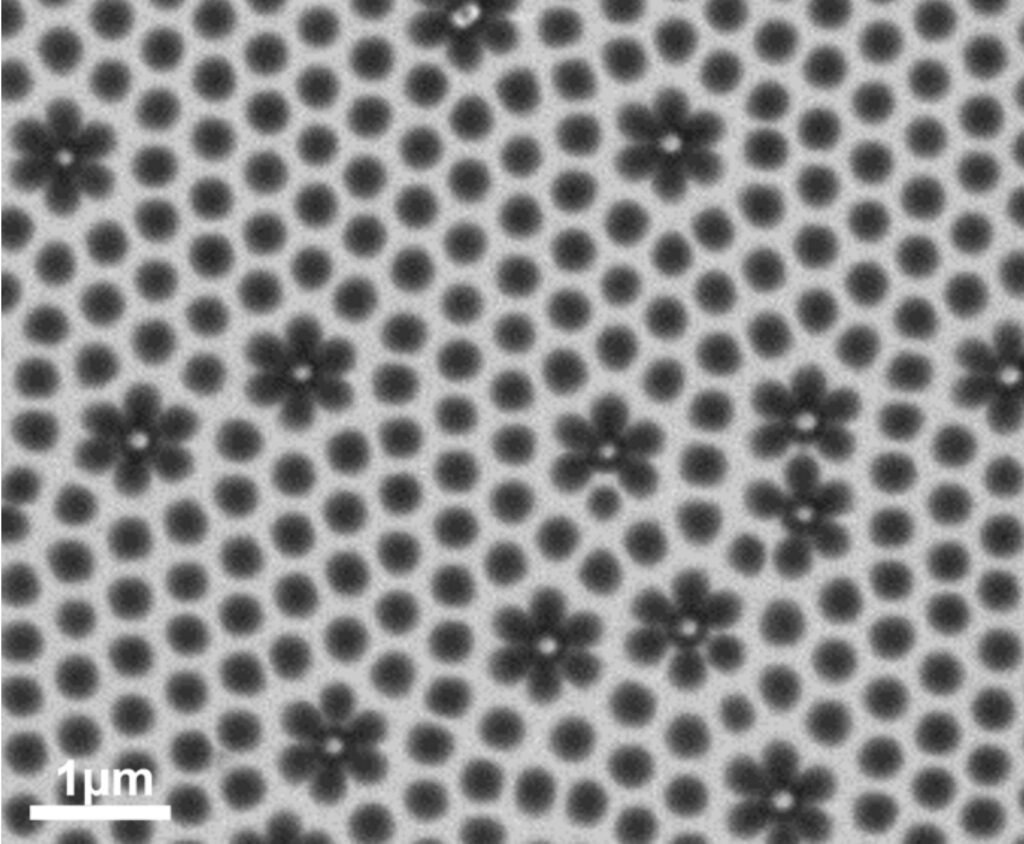Nanostructures from Colloidal Assembly
Creating defined surface patterns at the nanoscale is a key step for the design of different functional materials and coatings. We use self-assembled colloidal monolayers as templates and masks to create surface nanostructures. This colloidal lithography approach enables the preparation of high-quality surface patterns over macroscopic dimensions. We combine a fundamental interest in the physics of two-dimensional colloidal self-assembly and the design of emergent functionalities with a current focus on plasmonic properties.
Colloidal Lithography
The air/water interface can be an excellent confinement to assemble colloidal particles in two dimensions. Colloidal particles efficiently adsorb to the air/water interface and maintain sufficient mobility to self-assemble into well-ordered, two dimensional arrays. We can subsequently transfer these interfacial monolayers to a solid substrate to form patterns at the nanoscale.

Key related publications
N. Vogel, S. Goerres, K. Landfester and C.K. Weiss
A convenient method to produce close- and non-close-packed colloidal monolayers using direct assembly at the air-water interface and subsequent plasma induced size reduction
Macromolecular Chemistry and Physics 2011, 212, 1719
N. Vogel, M. Retsch, C.A. Fustin, A. del Campo and U. Jonas
Advances in Colloidal Assembly: The Design of Structure and Hierarchy in Two and Three Dimensions
Chemical Reviews 2015, 115, 6265
Control of structure and order
In contrast to top-down processes, self-assembly is inherently more limited to the available structural motifs and more prone to defects within the created nanostructure arrays. A current focus in our group is to overcome these limitations. We widen the achievable structural motifs by exploiting the compressibility of soft polymer shells surrounding hard particles. We also apply acoustic annealing to increase their overall order of colloidal monolayers.

Key related publications
J. Menath, J. Eatson, R. Brilmayer, A. Andrieu-Brunsen, D.M.A. Buzza, N.Vogel
Defined core-shell particles as the key to complex interfacial self-assembly
PNAS 2021, 118 (52), e2113394118
Simone Ciarella, Marcel Rey, Johannes Harrer, Nicolas Holstein, Maret Ickler, Hartmut Löwen, Nicolas Vogel, Liesbeth M. C. Janssen
Soft Particles at Liquid Interfaces: From Molecular Particle Architecture to Collective Phase Behavior
Langmuir 2021, 37, 17, 5364–5375
J. Menath, R. Mohammadi, J. C. Grauer, C. Deters, M. Böhm, B. Liebchen, L. M. C. Janssen, H. Loewen, N. Vogel
Acoustic Crystallization of 2D Colloidal Crystals
Advanced Materials 2023, 35 (2), 2206593
Colloidal lithography and plasmonic nanostructures
Colloidal lithography serves as a simple yet efficient tool to obtain wafer-scale nanostructuring. The process takes advantage of a colloidal monolayer on a substrate, which serve as nanoscale templates to create complex surface structures by a combination of (angular) deposition and etching steps. We develop new fabrication methods to increase the portfolio of available structural motifs and improve assembly and deposition techniques. We use this colloidal lithography to create arrays of complex plasmonic nanostructures with tailored optical properties over macroscopic dimensions. We currently focus on the hybridisation of resonances within plasmonic molecules, chiroptical plasmonics and lattice related effects such as surface lattice resonances. Our work enables access to large-area high quality substrates with unique optical properties without relying on state-of-art clean room technologies.

Key related publications
Eric S.A. Goerlitzer, Reza Mohammadi, Sergey Nechayev, Kirsten Volk, Marcel Rey, Peter Banzer, Matthias Karg, Nicolas Vogel
Chiral Surface Lattice Resonances
Advanced Materials 2020, 32, 2001330
Eric S.A. Goerlitzer, Mario Zapata-Herrera, Ekaterina Ponomareva, Déborah Feller, Aitzol Garcia-Etxarri, Matthias Karg, Javier Aizpurua, and Nicolas Vogel
Molecular-Induced Chirality Transfer to Plasmonic Lattice Modes
ACS Photonics 2023, 10 (6), 1821-1831
Eric Goerlitzer, Lutz Speichermann, Talha Mirza, Reza Mohammadi, Nicolas Vogel
Addressing the plasmonic hotspot region by site-specific functionalization of nanostructures
Nanoscale Advances 2020, 2, 394-400